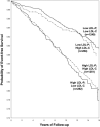The evolution and refinement of traditional risk factors for cardiovascular disease
- PMID: 22183062
- PMCID: PMC3310946
- DOI: 10.1097/CRD.0b013e318239b924
The evolution and refinement of traditional risk factors for cardiovascular disease
Abstract
Traditional risk factors for cardiovascular disease such as systemic hypertension and hypercholesterolemia, all described more than half a century ago, are relatively few in number. Efforts to expand the epidemiologic canon have met with limited success because of the high hurdle of causality. Fortunately, another solution to current deficiencies in risk assessment-in particular, the underestimation of risk both before and after initiation of pharmacotherapy-may exist. Parallel to the investigation of novel biomarkers, such as high-sensitivity C-reactive protein, ongoing research has yielded improved metrics of known causative conditions. This evolution of traditional risk factors, heralded by measures such as ambulatory blood pressure, central hemodynamics, low density lipoprotein particle concentration, genetic testing, and "vascular age," may better address the detection gap in cardiovascular disease.
Figures




Similar articles
-
Why patients with familial hypercholesterolemia are at high cardiovascular risk? Beyond LDL-C levels.Trends Cardiovasc Med. 2021 May;31(4):205-215. doi: 10.1016/j.tcm.2020.03.004. Epub 2020 Mar 12. Trends Cardiovasc Med. 2021. PMID: 32205033 Review.
-
Genetic determinants of inherited susceptibility to hypercholesterolemia - a comprehensive literature review.Lipids Health Dis. 2017 Jun 2;16(1):103. doi: 10.1186/s12944-017-0488-4. Lipids Health Dis. 2017. PMID: 28577571 Free PMC article. Review.
-
Clinical phenotype in relation to the distance-to-index-patient in familial hypercholesterolemia.Atherosclerosis. 2016 Mar;246:1-6. doi: 10.1016/j.atherosclerosis.2015.12.033. Epub 2015 Dec 25. Atherosclerosis. 2016. PMID: 26745182
-
Association of low-density lipoprotein cholesterol-related genetic variants with aortic valve calcium and incident aortic stenosis.JAMA. 2014 Nov 5;312(17):1764-71. doi: 10.1001/jama.2014.13959. JAMA. 2014. PMID: 25344734 Free PMC article.
-
Single Nucleotide Variants Associated With Polygenic Hypercholesterolemia in Families Diagnosed Clinically With Familial Hypercholesterolemia.Rev Esp Cardiol (Engl Ed). 2018 May;71(5):351-356. doi: 10.1016/j.rec.2017.07.010. Epub 2017 Sep 14. Rev Esp Cardiol (Engl Ed). 2018. PMID: 28919240 English, Spanish.
Cited by
-
Both diet and Helicobacter pylori infection contribute to atherosclerosis in pre- and postmenopausal cynomolgus monkeys.PLoS One. 2019 Sep 6;14(9):e0222001. doi: 10.1371/journal.pone.0222001. eCollection 2019. PLoS One. 2019. PMID: 31490998 Free PMC article.
-
Hypertension and traditional risk factors for cardiovascular diseases among treatment naïve HIV- infected adults initiating antiretroviral therapy in Urban Tanzania.BMC Cardiovasc Disord. 2023 Jun 20;23(1):309. doi: 10.1186/s12872-023-03332-6. BMC Cardiovasc Disord. 2023. PMID: 37340390 Free PMC article.
-
Effects of sleep deprivation on endothelial function in adult humans: a systematic review.Geroscience. 2021 Feb;43(1):137-158. doi: 10.1007/s11357-020-00312-y. Epub 2021 Feb 9. Geroscience. 2021. PMID: 33558966 Free PMC article.
-
Associations between intensive diabetes therapy and NMR-determined lipoprotein subclass profiles in type 1 diabetes.J Lipid Res. 2016 Feb;57(2):310-7. doi: 10.1194/jlr.P060657. Epub 2015 Dec 9. J Lipid Res. 2016. PMID: 26658239 Free PMC article.
-
Redox Balance Correlates with Nutritional Status among Patients with End-Stage Renal Disease Treated with Maintenance Hemodialysis.Oxid Med Cell Longev. 2019 Sep 5;2019:6309465. doi: 10.1155/2019/6309465. eCollection 2019. Oxid Med Cell Longev. 2019. PMID: 31583040 Free PMC article.
References
-
- Kannel WB, Dawber TR, Kagan A, et al. Factors of risk in the development of coronary heart disease--six year follow-up experience. The Framingham Study. Ann Intern Med. 1961;55:33–50. - PubMed
-
- Wang TJ. New cardiovascular risk factors exist, but are they clinically useful? Eur Heart J. 2008;29:441–4. - PubMed
-
- Pasternak RC, Abrams J, Greenland P, et al. 34th Bethesda Conference: Task force #1--Identification of coronary heart disease risk: is there a detection gap? J Am Coll Cardiol. 2003;41:1863–74. - PubMed
Publication types
MeSH terms
Substances
Grants and funding
LinkOut - more resources
Full Text Sources
Research Materials
Miscellaneous

